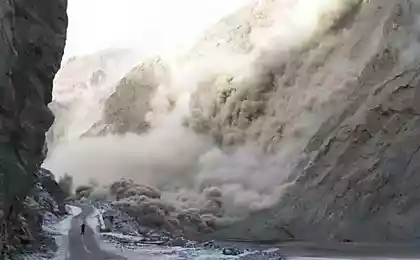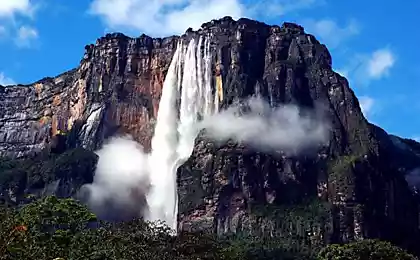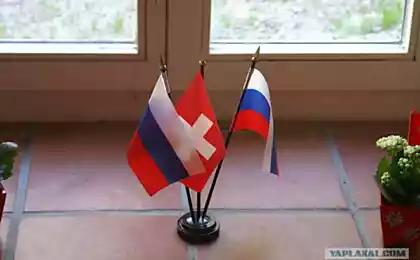1210
The most horrible inhabitants of the Amazon
I offer you the TOP 10 of the most terrible and frightening creatures that inhabit the Amazon River. Read more.
Black caiman (Black Caiman)
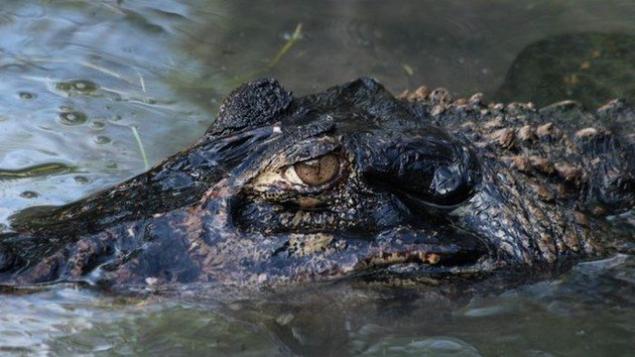
In fact, the black caiman alligator is on steroids. Black caiman can grow up to six meters in length, they are larger and heavier skull than the Nile crocodiles, and they are the top predators in the waters of the Amazon. This means that they are, in principle, are the kings of the river, they eat anything that will get them in the mouth, including piranhas, monkeys, freshwater bass, deer and anacondas.
Oh yes, it is worth noting that they readily attack people. In 2010, the black caiman attacked biologist named Deiz Nishimura (Deise Nishimura), while she was cleaning a fish in her houseboat. Despite the fact that she was able to fight back from him, black caiman took with him one of her legs. This caiman for eight months lived under her houseboat, apparently waiting for a convenient opportunity to attack.
Anaconda (Green Anaconda)
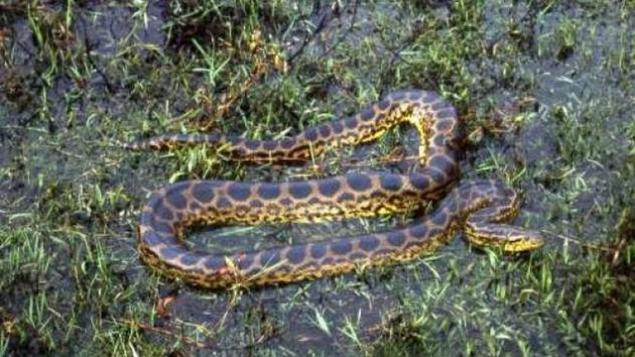
Continuing the theme of the giant reptiles, we present you the largest snake in the world that lives in the Amazon River - anaconda. Despite the fact that the length of the body retics be more anaconda is much heavier. Females anacondas tend more than males and can weigh up to 250 kilograms. The body length of the anaconda could be about 9 meters and the diameter of the body can be up to 30 centimeters. They are not poisonous, but use their formidable muscular strength to squeeze and strangle their victims, which include capybaras, deer, caimans, and even jaguars. Preferring shallow water, allowing them to sneak up on their prey, they tend to live not in the Amazon River, and in its branches.
Arapaima (Arapaima)

Arapaima also known as "puraruku" or "Peitsch" - a giant predatory fish that lives in the Amazon and adjacent lakes. Equipped with armored scales without much fear, they swim in waters infested with piranhas, and are themselves quite efficient predators, feeding on fish and the occasional bird. Arapaima prefer to stay close to the surface, because in addition to oxygen, which they get from the water through their gills, they still need to do breath of air, rising to the surface. Appearing on the surface, they make a distinctive sound like a cough. Their body length can reach 2, 7 meters and weighs 90 kilograms. These fish are so fierce that they have teeth, even in the language.
Giant otter (Giant Otter)
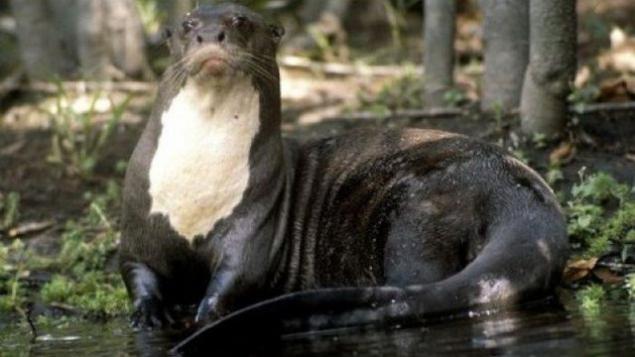
Brazilian otters are the largest freshwater otters. At the giant otter is the largest body length of just weasel family, and adult males can grow up to two meters when measured from head to tail. Their diet consists mainly of fish, crabs, they hunt in family groups of three to eight animals. They can eat up to four kilograms of seafood a day. However, many people find them cute, but do not let their good looks fool you, they are not harmless at all other creatures on this list. There were cases when a group of Brazilian otters killed and ate adult anacondas. They also can easily kill a caiman. During the observation of one of the groups giant otter has been observed that they killed and ate half meter caiman in 45 minutes. Despite the fact that their numbers are dwindling rapidly, in particular because of human intervention, they are considered one of the most powerful predators of the Amazon rainforest, hence their unofficial nickname was "river wolves».
CANDIRU or Candiru (Candiru)
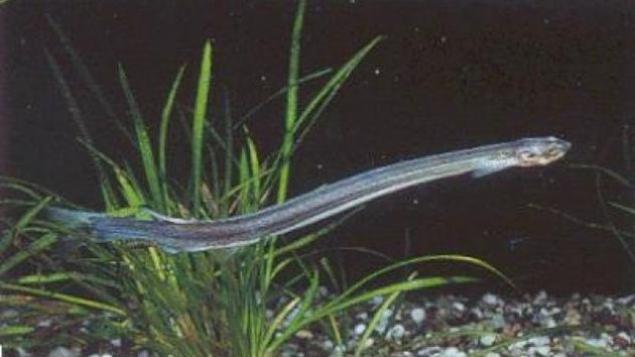
Amazon is teeming with not only the giants - little creatures that live in it, not less terrible, at least if you believe the stories about them. CANDIRU are small parasitic freshwater catfish that have become known for the fact that climb into the urethra of any fool who decide to pee in the river. Once in the urinary tract, they are firmly stuck there due to the thorns that grow along their backs. Despite the fact that the documented cases of small and raging debate about when such cases do occur, there is at least one documented case where a man needed an operation to extract CANDIRU from the urethra, with the fish tried to dig deeper, and almost reached scrotum. However, CANDIRU usually feed on fish, attaching themselves to the gills of larger fish by using spikes on their backs and feeding on their blood.
Sharks-bulls (Bull Sharks)

Despite the fact that sharks bulls tend to live in the salty waters of the ocean, they thrive in fresh water. There were cases when they swam so far on the Amazon River, which they saw in the city of Iquitos (Iquitos) in Peru, nearly 4000 kilometers from the sea. Their specific kidney perceive changes in the level of salt in the water and are adapted accordingly. And you certainly would not want to meet one of them in the river. These sharks often grow up to 3, 3 meters in length and weighs especially large specimens caught by fishermen, reached 312 kilograms. Like other sharks, bull sharks, there are several rows of sharp, triangular teeth and incredibly strong jaws that provide the bite force of 589 kilograms. They are also not averse to eat a man, and it is this kind of sharks often attack people (the second and third place is occupied by the tiger and great white sharks, respectively). The above characteristics, together with the fact that these sharks prefer to dwell near densely populated areas, has led to what many experts consider them the most dangerous sharks in the world.
Electric eels (Electric Eels)
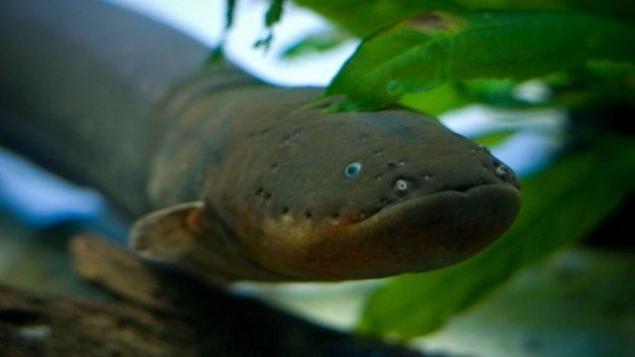
Electric eels are actually more closely related to the catfish than other acne, but you certainly do not want to approach them close enough to verify this independently. They grow up to 2, 5 meters long and can produce electrical discharges by means of special electric organs along their sides. These discharges can reach 600 volts, which is five times the power of the average American outlet, and enough to knock a horse down. Despite the fact that a discharge is not enough to kill a healthy adult, multiple shocks may cause heart or respiratory failure, and cases where people lost consciousness and sank after an attack electric eel, are not uncommon. Many of the missing persons, registered near the Amazon River, is associated with acne attacks that stunned people discharges electricity, and left to drown in the river. Fortunately for our species, despite the fact that acne carnivores, they tend to stick to the diet of fish, amphibians, birds and small mammals. They detect prey by sending a small, 10-volt discharges using their electric organs, and found her, kill, releasing a strong level.
Red-bellied piranha (Red-Bellied Piranhas)
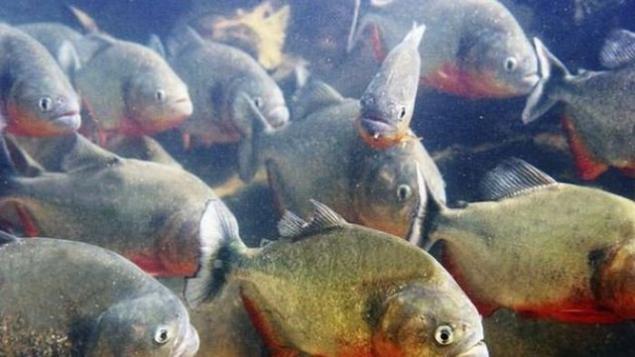
The quintessence of the horror of the Amazon River, is so frightening that served as inspiration for a number of controversial Hollywood movies, red-bellied piranha in fact, is primarily a scavenger. However, this does not mean that piranhas do not attack healthy creatures. They can grow up to 30 centimeters in length and usually swim in large groups, so they are weighty threat to most animals. Like all kinds of piranhas, red-bellied piranha have incredibly sharp teeth, which are arranged in a row on the upper and lower jaws of these fish. These teeth are closed completely, which makes them an ideal tool for tearing and lacerating the flesh of the victim. Their fearsome reputation is mainly derived from the "hectic eating" when a group of piranhas surround the unfortunate victim and devour her flesh to the bone in minutes. Such attacks are usually the result of a long hunger or provocation.
Payara (Payara / Vampire Fish)
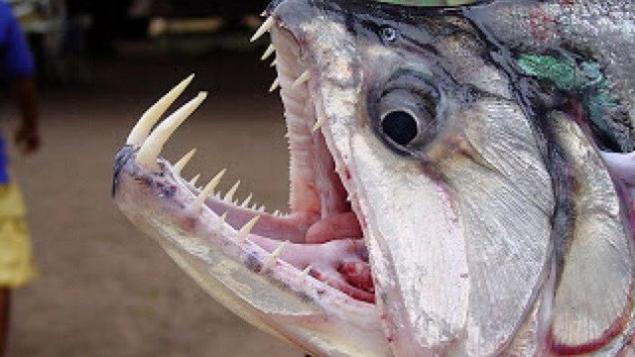
Despite their diminutive name payara is a ferocious predator, able to catch and consume fish, whose size is equal to half their own body. Given that the length of their bodies can reach 1, 2 meters, it is quite an impressive feat. Most of their diet consists of piranhas, which should give you some idea of how these can be fierce fanged fiends. Of these two mandibular cuspid rise, which can grow up to 15 cm in length. These tusks they use to literally stick to their sacrifice, after the rush on it. In fact, their teeth are so big that their upper jaw has special holes so that they are not pierced fangs themselves.
TAMBAQUI (Pacu)
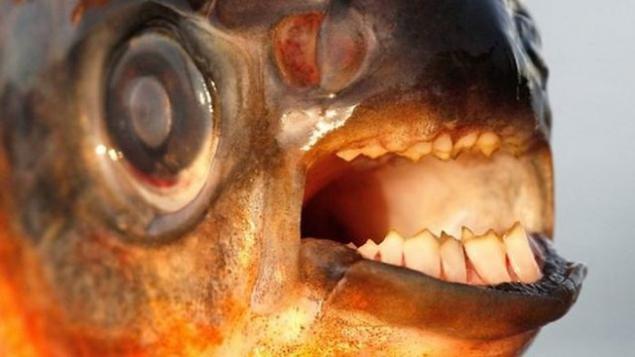
One creature that lives in the Amazon River, is much worse for men than for women. TAMBAQUI is much larger relative of the piranha, well known for its distinctive teeth, like a human. Unlike many other creatures on this list, pacu actually omnivorous and a large part of their diet are fruits and nuts. Unfortunately, for some pacu "nuts" is not only what pours from the trees. Yes, you understood correctly. There have been several cases where pacu bit off the testicles of male swimmers. In Papua New Guinea, a few men have died after the puck took their genitals for easy prey. Oh, and do not worry if you can not get into the Amazon to look at these monsters, which deprives men esteem - they have already begun to spread throughout Europe.
Black caiman (Black Caiman)

In fact, the black caiman alligator is on steroids. Black caiman can grow up to six meters in length, they are larger and heavier skull than the Nile crocodiles, and they are the top predators in the waters of the Amazon. This means that they are, in principle, are the kings of the river, they eat anything that will get them in the mouth, including piranhas, monkeys, freshwater bass, deer and anacondas.
Oh yes, it is worth noting that they readily attack people. In 2010, the black caiman attacked biologist named Deiz Nishimura (Deise Nishimura), while she was cleaning a fish in her houseboat. Despite the fact that she was able to fight back from him, black caiman took with him one of her legs. This caiman for eight months lived under her houseboat, apparently waiting for a convenient opportunity to attack.
Anaconda (Green Anaconda)

Continuing the theme of the giant reptiles, we present you the largest snake in the world that lives in the Amazon River - anaconda. Despite the fact that the length of the body retics be more anaconda is much heavier. Females anacondas tend more than males and can weigh up to 250 kilograms. The body length of the anaconda could be about 9 meters and the diameter of the body can be up to 30 centimeters. They are not poisonous, but use their formidable muscular strength to squeeze and strangle their victims, which include capybaras, deer, caimans, and even jaguars. Preferring shallow water, allowing them to sneak up on their prey, they tend to live not in the Amazon River, and in its branches.
Arapaima (Arapaima)

Arapaima also known as "puraruku" or "Peitsch" - a giant predatory fish that lives in the Amazon and adjacent lakes. Equipped with armored scales without much fear, they swim in waters infested with piranhas, and are themselves quite efficient predators, feeding on fish and the occasional bird. Arapaima prefer to stay close to the surface, because in addition to oxygen, which they get from the water through their gills, they still need to do breath of air, rising to the surface. Appearing on the surface, they make a distinctive sound like a cough. Their body length can reach 2, 7 meters and weighs 90 kilograms. These fish are so fierce that they have teeth, even in the language.
Giant otter (Giant Otter)

Brazilian otters are the largest freshwater otters. At the giant otter is the largest body length of just weasel family, and adult males can grow up to two meters when measured from head to tail. Their diet consists mainly of fish, crabs, they hunt in family groups of three to eight animals. They can eat up to four kilograms of seafood a day. However, many people find them cute, but do not let their good looks fool you, they are not harmless at all other creatures on this list. There were cases when a group of Brazilian otters killed and ate adult anacondas. They also can easily kill a caiman. During the observation of one of the groups giant otter has been observed that they killed and ate half meter caiman in 45 minutes. Despite the fact that their numbers are dwindling rapidly, in particular because of human intervention, they are considered one of the most powerful predators of the Amazon rainforest, hence their unofficial nickname was "river wolves».
CANDIRU or Candiru (Candiru)

Amazon is teeming with not only the giants - little creatures that live in it, not less terrible, at least if you believe the stories about them. CANDIRU are small parasitic freshwater catfish that have become known for the fact that climb into the urethra of any fool who decide to pee in the river. Once in the urinary tract, they are firmly stuck there due to the thorns that grow along their backs. Despite the fact that the documented cases of small and raging debate about when such cases do occur, there is at least one documented case where a man needed an operation to extract CANDIRU from the urethra, with the fish tried to dig deeper, and almost reached scrotum. However, CANDIRU usually feed on fish, attaching themselves to the gills of larger fish by using spikes on their backs and feeding on their blood.
Sharks-bulls (Bull Sharks)

Despite the fact that sharks bulls tend to live in the salty waters of the ocean, they thrive in fresh water. There were cases when they swam so far on the Amazon River, which they saw in the city of Iquitos (Iquitos) in Peru, nearly 4000 kilometers from the sea. Their specific kidney perceive changes in the level of salt in the water and are adapted accordingly. And you certainly would not want to meet one of them in the river. These sharks often grow up to 3, 3 meters in length and weighs especially large specimens caught by fishermen, reached 312 kilograms. Like other sharks, bull sharks, there are several rows of sharp, triangular teeth and incredibly strong jaws that provide the bite force of 589 kilograms. They are also not averse to eat a man, and it is this kind of sharks often attack people (the second and third place is occupied by the tiger and great white sharks, respectively). The above characteristics, together with the fact that these sharks prefer to dwell near densely populated areas, has led to what many experts consider them the most dangerous sharks in the world.
Electric eels (Electric Eels)

Electric eels are actually more closely related to the catfish than other acne, but you certainly do not want to approach them close enough to verify this independently. They grow up to 2, 5 meters long and can produce electrical discharges by means of special electric organs along their sides. These discharges can reach 600 volts, which is five times the power of the average American outlet, and enough to knock a horse down. Despite the fact that a discharge is not enough to kill a healthy adult, multiple shocks may cause heart or respiratory failure, and cases where people lost consciousness and sank after an attack electric eel, are not uncommon. Many of the missing persons, registered near the Amazon River, is associated with acne attacks that stunned people discharges electricity, and left to drown in the river. Fortunately for our species, despite the fact that acne carnivores, they tend to stick to the diet of fish, amphibians, birds and small mammals. They detect prey by sending a small, 10-volt discharges using their electric organs, and found her, kill, releasing a strong level.
Red-bellied piranha (Red-Bellied Piranhas)

The quintessence of the horror of the Amazon River, is so frightening that served as inspiration for a number of controversial Hollywood movies, red-bellied piranha in fact, is primarily a scavenger. However, this does not mean that piranhas do not attack healthy creatures. They can grow up to 30 centimeters in length and usually swim in large groups, so they are weighty threat to most animals. Like all kinds of piranhas, red-bellied piranha have incredibly sharp teeth, which are arranged in a row on the upper and lower jaws of these fish. These teeth are closed completely, which makes them an ideal tool for tearing and lacerating the flesh of the victim. Their fearsome reputation is mainly derived from the "hectic eating" when a group of piranhas surround the unfortunate victim and devour her flesh to the bone in minutes. Such attacks are usually the result of a long hunger or provocation.
Payara (Payara / Vampire Fish)

Despite their diminutive name payara is a ferocious predator, able to catch and consume fish, whose size is equal to half their own body. Given that the length of their bodies can reach 1, 2 meters, it is quite an impressive feat. Most of their diet consists of piranhas, which should give you some idea of how these can be fierce fanged fiends. Of these two mandibular cuspid rise, which can grow up to 15 cm in length. These tusks they use to literally stick to their sacrifice, after the rush on it. In fact, their teeth are so big that their upper jaw has special holes so that they are not pierced fangs themselves.
TAMBAQUI (Pacu)

One creature that lives in the Amazon River, is much worse for men than for women. TAMBAQUI is much larger relative of the piranha, well known for its distinctive teeth, like a human. Unlike many other creatures on this list, pacu actually omnivorous and a large part of their diet are fruits and nuts. Unfortunately, for some pacu "nuts" is not only what pours from the trees. Yes, you understood correctly. There have been several cases where pacu bit off the testicles of male swimmers. In Papua New Guinea, a few men have died after the puck took their genitals for easy prey. Oh, and do not worry if you can not get into the Amazon to look at these monsters, which deprives men esteem - they have already begun to spread throughout Europe.







